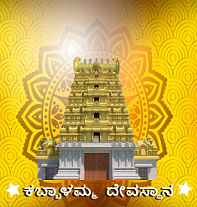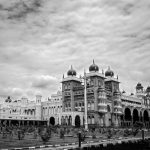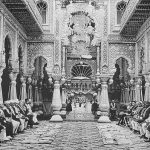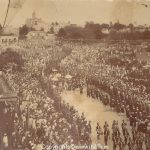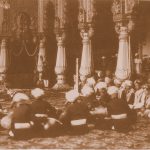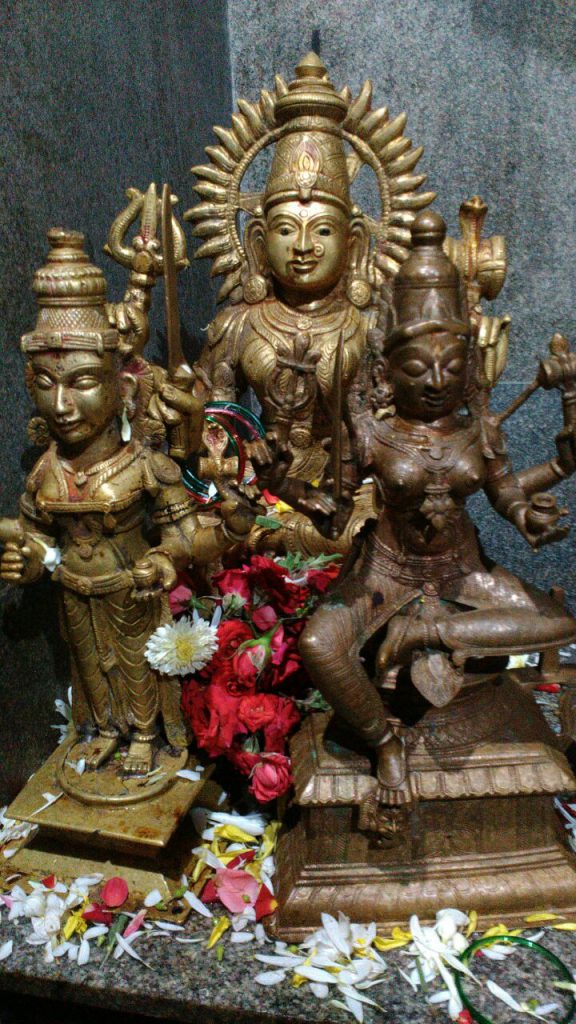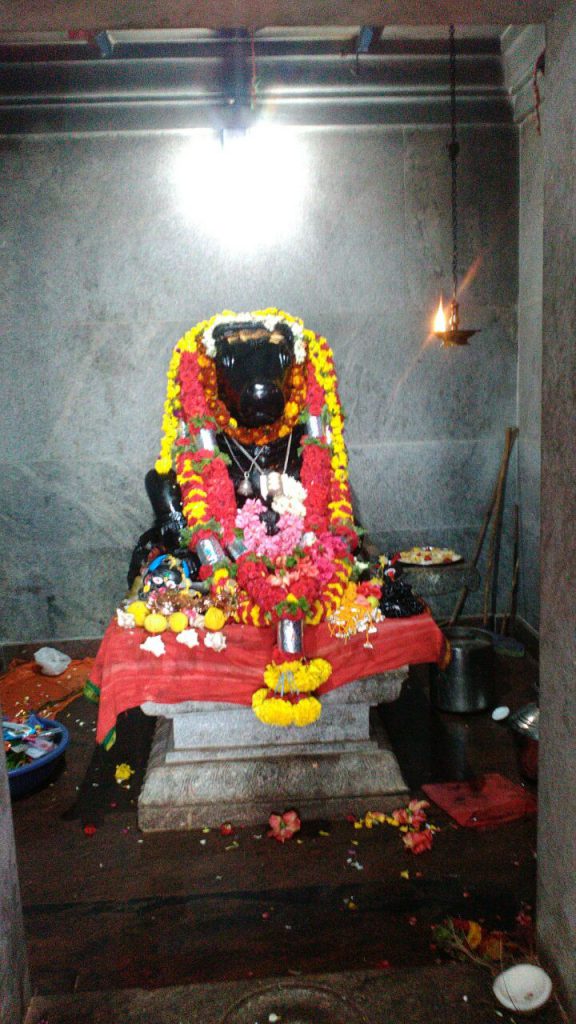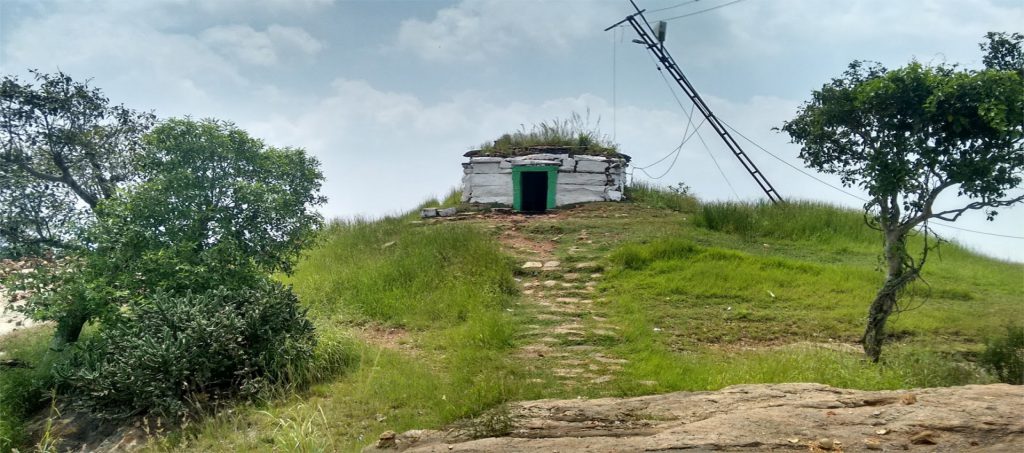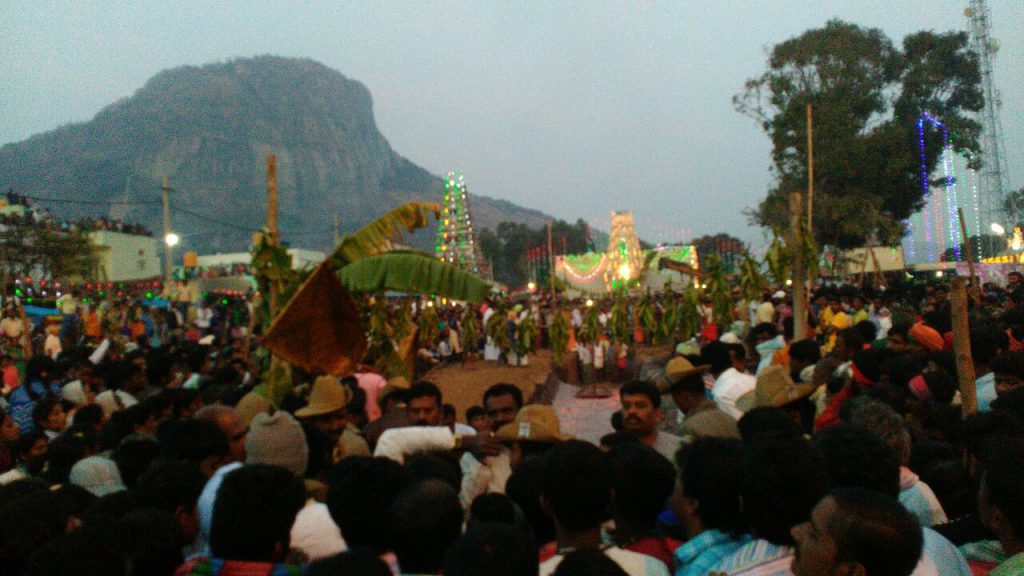
Shree Kabbalamma Temple
HISTORY
HISTORY
Jagadevaraya of Channapatna
Jagadevaraya of Channapatna was the father-in-law of Thimmaraj who was ruler of Penugonda. In AD 1577, when the sultans of Bijapur and Ahmednagar were trying to conquer Penugonda, Thimmaraja shifted his capital city to Chandragiri, and consequently the responsibility of forestalling the Sultans’ conquest fell on Jagadevaraya. A born adventurer and brave soldier, Jagadevaraya saved Penugonda from the humiliation by defeating the Bijapur army. Vijayanagar’s Sri Rangaraya, appreciating Jagadevaraya’s valour shown in third Penugonda battle, he bestowed the title Ghanagirirakshaka and a large region with 9 lakh pagodas as revenue. This region extending from Baramahal till the western ghats, comprised Mulubagilu, Piriyapatna, Kanakanahalli and Budihalu areas. To ensure convenient system of rule for this newly acquired big state, he made Channapattana as capital, built a fort in AD1586 which was later named as Channapattana. Also, it is stated that Sri Rangaraya married his daughter to Jagadevaraya.
Later, Peddajagadevaraya concentrated on the development of this region. Reinforcement of the fort at Kabbalu Durga which was closer to the then capital Channapattana, happened, perhaps, during Channapattana Paleyagara Peddajagadevaraya’s period. Kabbalu Durga has steep sides on all sides except one, and that is the only way to hike the Durga. Though there are carved steps on this face, they are very narrow, so it is tough to hike the hill even through these carved steps. If people stay with food and water reserves, they can escape enemy attacks..
Capital of Channapattana shifted to Kabbalu Durga
JSince the capital of Channapattana was an open land, to defend the enemies’ attacks conveniently, Peddajagadevaraya shifted his army base to the plains at the base of Kabbalu Durga. During his 15-year rule, Jagadevaraya had given a facelift to Channapattana rajya. When the army base was in Channapattana, he organised for a trading fair at Kabbalu grama. Locals confirm that from then on a fair takes place regularly till today. This Jagadevaraya-II, Jagadevaraya-III, and Ankusharaya (16 years) have ruled this region, says the folklore. In AD 1630, Mysore’s Chamaraja Wadeyar occupied Channapattana, and consequently parts of this state like Kanakanahalli, Piriyapatna became merged into Mysore and thus ended the rule of Channapattana Paleyagar. The mysore rulers also destroyed the army base in Kabbalu grama. The Kabbalu Durga fort assumed the status of prison fort for keeping prisons of war. Mysore’s royal family’s Krishnaraja-I had no progeny, and hence on his deathbed, he had directed his wife to adopt Chamaraja son of Ankanahalli’s Devaraja. As per her deceased husband’s wishes called the dominating Nanjarajayya, Dalavayi Devarajayya and Karachuri Nanjarajayya and explained the previous king’s wishes and enthroned Chamaraja in Ad1732 March 19th. By then Chamaraja had married and was 28 years of age. After he came to throne in 1655 AD, he married two – Devarajammanni, daughter of Shoolagiri Nanjarajaiah, and Devajammanni, daughter of Muguru family’s Alagangi Balaiah. After Chamaraja Wodeyar assumed power, for several months he tolerated the power wielded by Dalavayies. By that time, the rule was almost in the hands of Devarajayya of Kalale family and Karathuri Nanjarajayya and dictator Nanjarajayya. Dalavayies were handling all the financial and administrative matters of the palace. These three plotted to cheat the royal family by having agreements of financial benefits out of royal asset incomes. They also encouraged their subordinates to collect corrupt money and hand it over to them, by enticing them of higher positions in future. They also, using their authoritative power, acquired fertile lands at the border and divert the revenue from such acquisitions to themselves cheating the royal family.
Noticing this, Chamaraja Wodeyar put an end to Dalavayi powers and took a bold decision in 1732 AD. Dalavayi Devarajayya found out, by his notorious network of informants, the King’s decision, went and complained to Chamaraja’s step-mother by winning her confidence. He obtained the permission to run the administration at his will. Knowing this Chamaraja removed, in 1733 AD, removed Devarajayya and the dictatorial Nanjarajayya from their positions and appointed his close aids into the positions. Chamaraja Wodeyar appointed a Brahmin, Devayya to the position of Dalavayi Devarajayya, and appointed Virashetty in place of Nanjayya. He appointed Gopinathaiah as chief and gave him gifts. He also appointed Kanteeravaiah, Narayanappa, Kaduru Chikkaiah, Shivanappa, to his close planning committee. After that, Chamaraja ran his government independently, and as per the contemporary works Shringararaja Tilaka, Bana and other sources Chamaraja observed every administrative aspects with care. Like his predecessors, he extended donations and dutti to the temples and pundits. Srirangapattana is learned to have thrived with trade, ethics and efficiency. Officers appointed by Chamaraja executed their authority properly and sincerely.
Chamaraja was not fortunate enough to continue as king. Displaced Dalavayies were waiting for an opportunity to end his rule. In the meantime, Chamaraja took some financial reforms. Step-mother Devarajamma was donating sums to religious institutions and also had appointed a number of unnecessary attendants for her service. In the name of these religious functions, her servants were drawing a lot of things from the palace stores. Besides this, they were giving false account of requirements, though there were no religions functions, the things were transferred to their own homes. This information also came to Chamaraja’s notice, who thought of new rules in this regard. Those who thought would get affected by the King’s new rules started to brainwash his step-mother.
Army rebelled against the King
Waiting for this time, Kalale brothers invited Jamadar Hyder Ali, who was working under the army chief, Muddagiri Mallaiah, along with some others and incited them to after taking their salaries, to tell the King that they would not turn up to duty and rise against the Kingdom. Agreeing to this 2000 horse riders and 6000 soldiers just stood at the entrance of the fort.
After the army rebelled against the King, Kalale brothers took over the power themselves and started robbery and spread terror during nights. Unaware of the plot, Chamaraja Wodeyar had to submit to a peace agreement with Dalavayi Devarajayya. The cunning Devarajayya did not stop there. He got the main doors of the place removed and snatched all royal symbols and placed on the royal throne. Thus, he succeeded to dethrone the King in 1734 AD on June 10, and imprisoned all his loyal officers.
The King and his three wives were kept under house arrest at different locations in Srirangapattana. After a few days, the King and his wives were secretly sent to the Kabbalu Durga. No one in Srirangapattana knew out what happened to King Chamaraja and his wives, after the rebellion. Even the Kabbalu grama people themselves did not know that their King & his wives are at their very own place.
The King and his three wives were kept under house arrest at different locations in Srirangapattana. After a few days, the King and his wives were secretly sent to the Kabbalu Durga. No one in Srirangapattana knew out what happened to King Chamaraja and his wives, after the rebellion. Even the Kabbalu grama people themselves did not know that their King & his wives are at their very own place.
Kabbalu Durga had a seven-level fort
Kabbalu Durga had a seven-level fort
Kabbalu Durga had a seven-level fort. There is a Koteshwara Temple and a Lamp Stone Pillar can be seen. Donating land to this temple is mentioned in the 1250 AD, of the Kanakapura Shasana No.66 (Tamil Shasana). It can, therefore, be said that the fort was certainly built during the Hoysala dynasty’s rule or even before that. After crossing the 2nd level of the fort, at the 3rd level, there is small water pond and a cave transformed into a temple. In this there are two small ponds and God Shri.Chikka Srinivasamurthy’s idol is inside, and this God is also called Shri.Ranganathaswamy. Some 200 steep steps are carved in the rock from the 3rd level. At the entrance of the 4th level, there is a water pond and then sloping rock face without steps, and one has to climb with caution. Then the 5th level, from where we can see 40 Kaagadi-like steps carved into the rock face. 6th level of the fort has a 50 feet by 60 feet grain storage, and storage places for ghee and oil, and has a water pond as well. On the west side, there is a deep gorge with an equipment to drop the dead bodies of the dead, into the gorge. To the left way to the Temple, weapons storage and guards’ houses are situated. Further, the 7th row of the fort is built with mud and stores and is 600 feet long and 300 feet wide fort. This holds a palace (now, we can see only its remains).
Two wooden idols
On the top of the Kabbalu Durga, there is the Bhimeshwara Temple where defaced Shiv Linga can be seen. Also, there are two Ganapathi’s idols (also defaced). In this Bhimeshwara Temple, there Sanctum and Navaranga (where worship activities are held) sections are there. The Temple has west-facing entrance, a lamp lighting pillar, and has, to the east, a big round-shaped water pond with a diameter of 100 feet.
Anticipating risk to their lives, had infused small amount of poison to the Bhimeshwara Temple’s adjacent pond’s water. When they were kept in house-arrest in Shri Rangapattana, they had kept with them two wooden idols of their family’s Godess Shri Chamundeshwari’s another form of Shri.Kaalidevi. And when they were secretly shifted to Kabbalu Durga also, they did not forget to carry these idols with them. They were not objected to carry the idols at that time. Now the King Chamaraja and his wives established these idols in two places in the Kabbalu Durga palace and continued to worship, which gave them solace. Since in the Kanakapura, located to the east of Kabbalu Durga, Shasana No.65 Shri.Kalikaadevi is mentioned, later Shri. Kalikaadevi is called Shri.Kabbalamma, as per some people. The idol of Shri.Kabbalamma was found in Kabbalu grama as far back as 1429 AD, and has document backup for the same. It is a fact that even now we can see the basic idol of Shri.Kaalikadevi but it is lying defaced in a corner of the circular pond on top of the Durga.
Out of the two wooden idols, the one worshipped by the second wife of King Chamaraja was brought to the palace by Mysore kings after conquering Mysore from Hadinadu. After this idol was established in the Mysore palace, the royal family had gained many successes and became auspicious to them. Some say, this idol was established with religious rituals with ancient procedures and was worshipped by great sages, and hence this Shri.Kaalidevi’s idol had mysterious power and ability. This idol was being worshipped by King Chamaraja’s second wife, Shoolagiri Nanjaraja’s daughter, Devajiammanni, in Shrirangapattana. The third of Chamaraja also requested for an opportunity for her also to worship this idol. Since the second wife did not agree to this, King Chamaraja got another similar idol made by his royal sculptors and gave it to his third wife.

DAILY ROUTINE OF THE KING AND QEENS IN KABBALU DURGA
1King Chamaraja and his wives
It is appropriate here to mention the security strategies adapted when King Chamaraja and his wives were imprisoned in the Kabbalu Durga.
At the top of Kabbalu fort some drums, kahale and horns were stationed. The guards used to beat drums in high pitch at the moment of sunrise, and this was repeated at the time of sunset. They used to follow rhythms of drum beating following the shadows of the lamp post created by the sun’s position. Also observing, from the top of the Durga, the activities of enemy’s army and imminent attacks to the concerned places through their Kombu, kahale. Every evening, indicating everything is in order, they used light a fire visible afar. When the drum beating started at the sunrise, King Chamaraja and his wives routine would start. Guards would come and in their presence, entrance to the 7th row of fort would be opened. The King and his wives had to register their presence from the sit out of the palace, to any new guards. Then the entrance to the 7th row of the fort would be closed. Only when the night guards crossed the 1st row of the fort and when all the rows entrances are closed, the King and his wives were allowed to go around in the 7th and 6th rows of the fort.
Exactly at noon they had to go back in to the 7th row, and again in evening, entrance to the 7th row would be kept open for a short time. Then, after visiting the temple, before the new guards took their attendance, they had to be in the palace in the 7th row. After they were permitted to go out of the 7th row, King Chamaraja would bathe in the big round pond and sit worshipping the Shiva Temple there. Meanwhile his wives would bathe in the palace from the water provided by the guards, and offer their namaskaras to the family godess Shri Kaalikadevi. While the 2nd and 3rd wives of the King worshipped the wooden idols of Shri.Kaalikadevi, the first wife would worship base state of Shri.Kaalikadevi at the pond outside. Then, they all would visit the Shiva temple, and after the offerings to the God were over, would return to the palace, rest for a while and would eat the food brought by guards and would go for meditation.
2The King’s ashes
Evening, when the fort was opened would visit the Shiva temple, light a lamp, and sit there for a while and would return to the palace. This would conclude their daily routine. After sometime, (may be because he drank from the poisoned water of the pond) The King got seriously sick and died. Unlike the procedure of dropping dead bodies from the 6th row into the deep gorge, the concerned officers did not agree to dispose body of the King. So, after lengthy discussions, a decision to cremate his body near the Shri.Ranganatha temple. With lot of efforts, his body was brought to the spot, laid on the pyre prepared by the guards. His three queens by lighting the pyre cremated him. Evening the three queens were taken back to the palace on Kabbalu Durga. Next day when the queens requested to collect the King’s ashes, the guards informed the concerned officers and again after lengthy discussions, it was permitted. When the queens were brought from the Durga to the cremation spot, the pyre had not subsided.
Queens’ were inconsolable while waiting at the burning pyre. By evening, the guards assisted the queens to collect the ashes, though it was still burning. Then another queen took a metal pail and started collecting the ashes to everyone’s surprise, but no one spoke about it. She took that pail of ashes to Shri.Ranganatha temple, placed it before the God and offered namaskaras. Seeing this, the other queens also took their pails, placed in before the God and offered namaskaras. The first queen, crying loudly took the pail of ashes and poured on the idol of Shri.Ranganatha, but the guards and the other queens were dumbfounded and could do doing nothing about it. Their distressed mourning cry was so terrible, that it was with great efforts that they could console them take them to the place at the top of the Durga.
On the 13th day of the King’s death, the traditional ceremonies were to be held. Though difficult to make arrangements, the guards brought as many things as possible without the notice of the officers. The queens bathed in the nearby pond and were sitting quietly without eating since morning. When the guards tried to console them, one of the queens asked them to take them to the Shri.Ranganathaswamy temple. When they were taken there, the lamp lit in the morning was still burning. they bathed the God’s idol with water and lighted the oil lamp and sat down there quietly. The lamp which they lighted was still burning till the evening. When the annual ritual was to be performed, the queens went to Shri.Ranganatha temple repeated their method by pouring the King’s ashes on the idol. This continued as long as they lived.
3Gramas of Kabbalu
Later, there is no information as to when the King Chamaraja’s first wife died. Subsequently, his 2nd wife Shoolagiri Nanjaraj’s daughter Devajammanni died. Now, only his 3rd wife, Muguru Alaganki Balaiah’s daughter, Devajammanni remained in Kabbalu fort. By this time, in the Shrirangappattana palace, all had forgotten about the King Chamaraja, and there was no precaution needed to be taken about the political steps the remaining queen would take. Hence permission was sought to shift her from the Kabbalu Durga. The chiefs of the Shrirangapattana state, reviewing this request, decided to shift her to the Harihara grama fort, as prisoner.
The Harihara grama is located at the foothills of Basavana Betta (near Kanakapura Taluk’s Sathanuru) which is at a small distance from Kabbalu Durga, and shifted her. Among all the things, the 3rd queen only took the wooden idol of Shri.Kaalikadevi with her when leaving Kabbalu Durga palace. That is, she did not take the original idol of Mysore which Shoolagiri Nanjaraja’s daughter devajammanni was worshipping. No information is available about that original idol and other things the queens were using.
Gramas of Kabbalu, learning the practice of pouring burning ashes on Shri.Ranganatha idol, started to continue the celebration as a fair. Even today, during the annual fair, the ritual of pouring burning ashes on Shri.Ranganatha idol continues.
4Shoolagiri Nanjaraja worshipped Shri.Kaalikadevi idol
It is believed that since the queen Devajammanni, daughter of Shoolagiri Nanjaraja worshipped Shri.Kaalikadevi idol wholeheartedly, wishes of the queens were fulfilled by Devi, and consequently the Kalale brothers Devarajayya and Nanjarajayya were, gripped in her curse, fought with each other and lost their honour.
As the 3rd wife of King Chamaraja, Devajammanni, daughter of Muguru Alaganji Balaiah, was taken and imprisoned in the Harihara grama fort of previous Alaganadu king. Sigalanadu king of Harihara was a favourite underling of Vijayanagar empire. Vijayanagar’s Proudaraya had an addiction to hunt elephants. He used to snare the elephants, train them and add to his army. When he came to Sigalanadu hunting elephants, he camped in the newly built fort at Kappedoddi, and thus got its name Harihara fort. When Proudaraya of Vijayanagara came to this grama, he had sanctioned funds to build a temple there. Sigalanadu Prabhus using the funds got a Shiva (Harihara) temple. At the time of installing Linga, rare Akshamala Ganapathi and Durga idols were also installed in the temple. Now, these idols are defaced and the Basava idol has been brought out of the temple and kept there. There are many more defaced idols at the Basava idol, among them Brahmarakshasa’s head and a Durga idol are still beautiful.
This Durge is holding in her many hands, damaruga, sword and thrishul, but the face is broken. It is said that the Shiva Linga of this temple has now been installed in a different place. Alongside this fort, there is a jungle track leading to the Basavana Betta. On the rock at the lake’s bund footprints of the Basavana Betta God Shri.Hebbetturayappa can be seen. Devotees would bathe in the lake and touch these footprints and then would proceed to hike the Betta. In this Harihara grama, along with the palu Harihara temple, Jain religions Thirthankara idols are also there. This region is also called Shravanana Oddu.
5Queen Devajammanni
Chamaraja Wodeyar’s third wife Devajammanni was brought to Harihara a prisoner, spent her final days there and died. The fort has deteriorated and hardly seen now. But the Honne tree wooden idol of Kaalikadevi, left over by the Queen Devajammanni, is still there, which is called as Maaramma by the grama people. The earlier godess of Harihara Shri.Konthamaramma’s idol is located adjacent to this wooden idol.
During 1759 AD, under the leadership of Gopala Hari, Maratha army raided the Channapattana region and destroyed many places and durgas, and Kabbalu Durga was also among them.
After several days of this, a farmer came and met Shri.Ramaiah, who was the head of the grama and chief of Brahmins. He informed that while he was extracting the valmika soil for the domesticated chicken, he found an idol there. Immediately, Shri.Ramaiah went there and saw a part of the idol projected from the dug place. He got the spot completely dug, and found a Goddess’s idol. He brought the idol and built a temple for that and started conducting pooja vidhi-vidhanas to the godess. Later, Mysore kings and Hyder Ali Khan, considering the periodic battles, arranged for renovation of the Kabbalu Durga and named it Jafarabad, name did not stand for long. During 1864 AD, all the phirangis and ammunition was destroyed and shifted the army personnel.
6Kabbalu-Jaatre started
